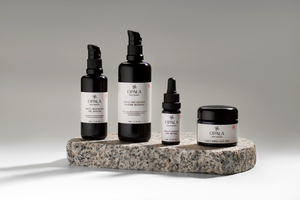|
1. FRAGRANCE
LOOK FOR - Fragrance, perfume, parfum, aroma
FUNCTION - Fragrance is defined as a combination of chemicals that gives each perfume or cologne its distinct scent.
HEALTH CONCERN - Some have evidence linking them to health effects including cancer, reproductive toxicity, allergies and sensitivities.
2. PARABENS
LOOK FOR - Ethylparaben, butylparaben, methylparaben, propylparaben, isobutylparaben, isopropylparaben, other ingredients ending in –paraben
FUNCTION - Parabens are preservatives used in a wide variety of personal care products to prevent the growth of microbes. These endocrine-disrupting chemicals can be absorbed through skin, blood and the digestive system.
HEALTH CONCERN - Endocrine disruption, cancer, developmental and reproductive toxicity.
3. PETROLATUM
LOOK FOR - Petrolatum, Petroleum Jelly, Paraffin Oil, Mineral Oil
FUNCTION - Derived from petroleum, it is often used in personal care products as a moisturising agent.
HEALTH CONCERN - Cancer. The primary concern with petrolatum is the potential contamination with PAHs (when not properly refined).
4. PHENOXYETHANOL
LOOK FOR - Phenoxyethanol, 2-Phenoxyethanol, Euxyl K® 400
FUNCTION - Phenoxyethanol is used as a preservative in cosmetic products and also as a stabilizer in perfumes and soaps.
HEALTH CONCERN - Allergies, nervous system effects.
5. PHTHALATES
LOOK FOR - Phthalate, DEP, DBP, DEHP and fragrance
FUNCTION - Widely used in scented products to help the scent linger, although it is rarely found on labels because it is a constituent of the ubiquitous ingredient “fragrance.”
HEALTH CONCERN - Endocrine disruption, developmental and reproductive toxicity, cancer.
6. FORMALDEHYDE
LOOK FOR - Formaldehyde, quaternium-15, DMDM hydantoin, imidazolidinyl urea, diazolidinyl urea, polyoxymethylene urea, sodium hydroxymethylglycinate, 2-bromo-2-nitropropane-1,3-diol (bromopol) and glyoxal.
FUNCTION - They help prevent microbes from growing in water-based products.
HEALTH CONCERN - These chemicals can be absorbed through the skin and have been linked to cancer and allergic skin reactions.
7. PEG
LOOK FOR - PEG-(followed by a number), polyethylene glycol, PPG, polypropylene glycol.
FUNCTION - These petroleum-based chemicals are used to thicken, soften, and help products to retain moisture.
HEALTH CONCERN - They cause skin irritation and system toxicity, especially when used on damaged or broken skin.
8. SULFATES (SLS, SLES)
LOOK FOR - Sodium laureth sulfate, sodium lauryl sulfate, sodium lauryl ether sulfate, anhydrous sodium lauryl sulfate, and irium.
FUNCTION - Penetration enhancers, detergents (foaming), they attract both oil and water allowing dirt and grime to be lifted from the skin.
HEALTH CONCERN - Strip natural oils from skin, causing dryness, allergic reaction, and irritation.
9. CHEMICAL SUNSCREENS
LOOK FOR - Oxybenzone, Octinoxate (Octylmethoxycinnamate), Homosalate, Octisalate, Octocrylene, Avobenzone
FUNCTION - UV protection, skin damage (ageing) protection
HEALTH CONCERN - Mimic estrogen in the body, potentially causing hormonal disruption.
10. DIMETHICONE
LOOK FOR - Dimethicone, methicone, phenyl trimethicone, cyclomethicone, dimethiconol, and dimethicone copolyol.
FUNCTION - Dimethicone is a silicone-based polymer found in a wide range of cosmetics and personal care products. It is used to create a soft, smooth feel on skin and hair.
HEALTH CONCERN - This ingredient blocks pores from drawing moisture from the air and releasing toxins, and often leads to acne and irritation.
+1 ALCOHOLS
There are different types of alcohols, all with different properties, we will explain their functions and potential risks on a following blog.
|




